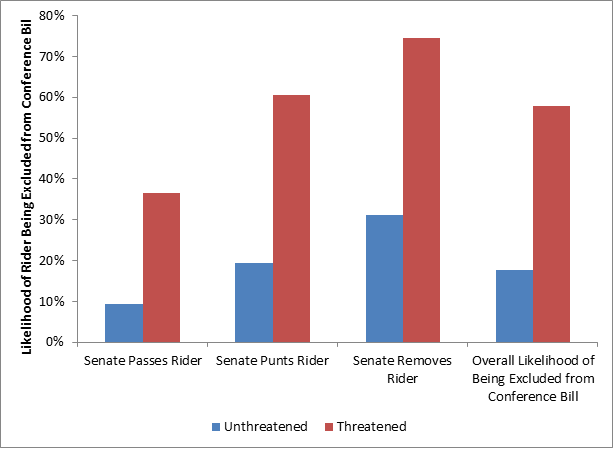
 Though Donald Trump will enter the White House facing both a Republican controlled House and Senate, Congress is unlikely to be a rubber stamp on his legislative agenda. Traditionally, presidents use the threat of legislative veto to move policy closer to their own preferences, but these threats tend to not be credible. In new research, Hans Hassell and Sam Kernell look closely at one type of veto threat – those made to resist extra legislation and spending on annual spending bills. He finds that such threats to veto riders can influence legislation by encouraging bipartisanship in the legislative process, especially in the Senate.
Though Donald Trump will enter the White House facing both a Republican controlled House and Senate, Congress is unlikely to be a rubber stamp on his legislative agenda. Traditionally, presidents use the threat of legislative veto to move policy closer to their own preferences, but these threats tend to not be credible. In new research, Hans Hassell and Sam Kernell look closely at one type of veto threat – those made to resist extra legislation and spending on annual spending bills. He finds that such threats to veto riders can influence legislation by encouraging bipartisanship in the legislative process, especially in the Senate.
At the start of the 114th Congress in 2015, President Obama encouraged Republican leaders in the Senate to work together with him to achieve common ground recognizing that while there were many things on which they disagreed, there were also many opportunities for collaboration. Yet, on the very same day that President Obama had talked about working together with his political opponents, the president had also threatened to veto two bills introduced and reported by House committees. Five days later he threatened three more on his way to a total of eight veto threats in the first month of a congressional session — the most by any president since veto threats began to be formally recorded in 1985. As of early November 2016, President Obama had threatened to veto 59 different bills in the second session of the 114th Congress alone. Though president-elect Donald Trump will enter the White House with both the House of Representatives and the Senate on his side, it may not be entirely smooth sailing for his agenda; presidential vetoes have not been unknown during periods of unified government.
The use of such threats is not unprecedented and presidents have regularly threatened bills they find lacking or undesirable. Yet, presidents, contemplating the use of such threats, would find prevailing political science theory about their effectiveness discouraging. While presidents might want to utilize veto threats to move policy closer to their own preferences, the traditional view of veto threats is that they are minimally effective because threats are either non-credible and thereby, can only minimally influence legislators, or alternatively, that they are highly credible, allowing legislators to pinpoint the president’s minimally acceptable policy. This ineffectiveness should be especially true for threats directed at riders to appropriations bills, extraneous legislation and spending restrictions attached to “must have” annual spending bills.
In spite of this negative view of the effectiveness of veto threats to resist riders, presidents have increasingly threatened to veto appropriations bills because of these riders. Table 1 shows the number of riders to appropriations bills threatened by presidents. Using 989 threatened and unthreatened riders to annual appropriations, Sam Kernell and I examine the effectiveness of veto threats at removing these objectionable provisions and moving legislation closer to the president’s preferences.
Table 1 – The Distribution of SAP-Threatened Riders across Congresses
| Party Control of | Threatened Riders Origin | |||||||
|---|---|---|---|---|---|---|---|---|
| Congress | Presidency | House (Seat %) | Senate (Seat %) | # of Threatened Riders | HAC | HF | SAC | SF |
| 99th (1985-1986) | Republican | Democrat (58.2%) | Republican (56%) | 1 | 0 | 0 | 1 | 0 |
| 100th (1987-1988) | Republican | Democrat (59.3%) | Democrat (55%) | 12 | 6 | 3 | 1 | 2 |
| 101st (1989-1990) | Republican | Democrat (59.8%) | Democrat (55%) | 8 | 7 | 0 | 1 | 1 |
| 102nd (1991-1992) | Republican | Democrat (61.6%) | Democrat (56%) | 16 | 12 | 0 | 2 | 2 |
| 103rd (1993-1994) | Democrat | Democrat (61.4%) | Democrat (57%) | 0 | 0 | 0 | 0 | 0 |
| 104th (1995-1996) | Democrat | Republican (53.1%) | Republican (52%) | 37 | 28 | 2 | 7 | 0 |
| 105th (1997-1998) | Democrat | Republican (52.4%) | Republican (55%) | 30 | 27 | 1 | 3 | 0 |
| 106th (1999-2000) | Democrat | Republican (51.5%) | Republican (55%) | 34 | 34 | 0 | 0 | 0 |
| 107th (2001-2002) | Republican | Republican (50.8%) | Democrat (50%) | 3 | 3 | 0 | 0 | 0 |
| 108th (2003-2004) | Republican | Republican (52.6%) | Republican (51%) | 40 | 30 | 0 | 0 | 10 |
| 109th (2005-2006) | Republican | Republican (53.3%) | Republican (55%) | 26 | 26 | 0 | 0 | 0 |
| 110th (2007-2008) | Republican | Democrat (53.6%) | Democrat (50.5%) | 54 | 51 | 0 | 0 | 3 |
Unlike conventional models of veto threats as minimally effective efforts to influence legislation, our findings depict presidents’ veto rhetoric as an integral feature of a bargaining game between opposing party teams seeking to coordinate on policy. Because the president is part of a party team, timely, credible veto threats prompt legislators to reassess which legislative bundles stand the best chance of achieving their policy goals. With veto threats, presidents also send strong signals identifying for both the public and co-partisans in Congress those policies on which the parties disagree.
Presidential veto threats influence legislation by solidifying partisan preferences and encouraging partisan teamwork through the legislative process. As should be expected, the effect of veto threats in the legislative process reflects the institutional differences between the House and Senate. In the House, threats have little to no effect. Instead, veto threats have a strong effect on the outcomes in the Senate. In the Senate, they increase the likelihood of filibusters by 14 percent, they increase the use of non-textbook legislative processes by 25 percent, they increase the likelihood that the Senate will gridlock and be forced to “punt” the bill to conference to gain traction as part of an omnibus bill by 19 percent, and they increase the likelihood that the rider will be removed by the Senate by 15 percent. In short, we find that compared to a similar set of unthreatened riders, threatened riders face much larger hurdles to passage.
Moreover, at the end of the process, veto-threatened riders are less than half as likely to survive to the enrolled bill stage as are unthreatened riders. As Figure 1 below shows, overall, the presence of a veto threat increases the likelihood that a rider will be removed prior to final passage of the bill from 18 percent to 58 percent.
Figure 1 – Likelihood of Conference excluding HAC riders across different Senate actions and veto threatened status*

Probabilities are simulation estimates from Model 1 in Table 4 in paper including controls. All differences are significant at the p<.05 level.
Our results show that presidential veto threats are not just cheap talk, but rather are an integral part of the process that allows legislators to identify critical areas of legislation that must be resolved in order to avoid gridlock and pass annual appropriation. With veto threats chalking up such success, and with presidents increasingly enlisting them to counter objectionable legislation, veto threats appear to carve out a crucial role for presidents in the legislative process.
This article is based on the paper, ‘Veto Rhetoric and Legislative Riders’ in the American Journal of Political Science.
Featured image credit: Tony Webster (Own work) [CC BY-SA 3.0], via Wikimedia Commons
Please read our comments policy before commenting.
Note: This article gives the views of the author, and not the position of USAPP – American Politics and Policy, nor the London School of Economics.
Shortened URL for this post: http://bit.ly/2gsR1o7
_________________________________
 Hans J.G. Hassell – Cornell College
Hans J.G. Hassell – Cornell College
Hans J.G. Hassell is an Assistant Professor of Politics at Cornell College. His research focuses on political parties, elections and political behavior, and Congress. He is also interested in how the contextual political environment, especially aspects such as race, ethnicity, and immigration, affect political behaviors. His work has appeared in the Journal of Politics, the American Journal of Political Science, and Political Behavior. Hans’s website: http://people.cornellcollege.edu/hhassell/
 Sam Kernell – UC San Diego
Sam Kernell – UC San Diego
Sam Kernell is a Professor of Political Science, at the University of California, San Diego. His research focuses on the American presidency and political history.





